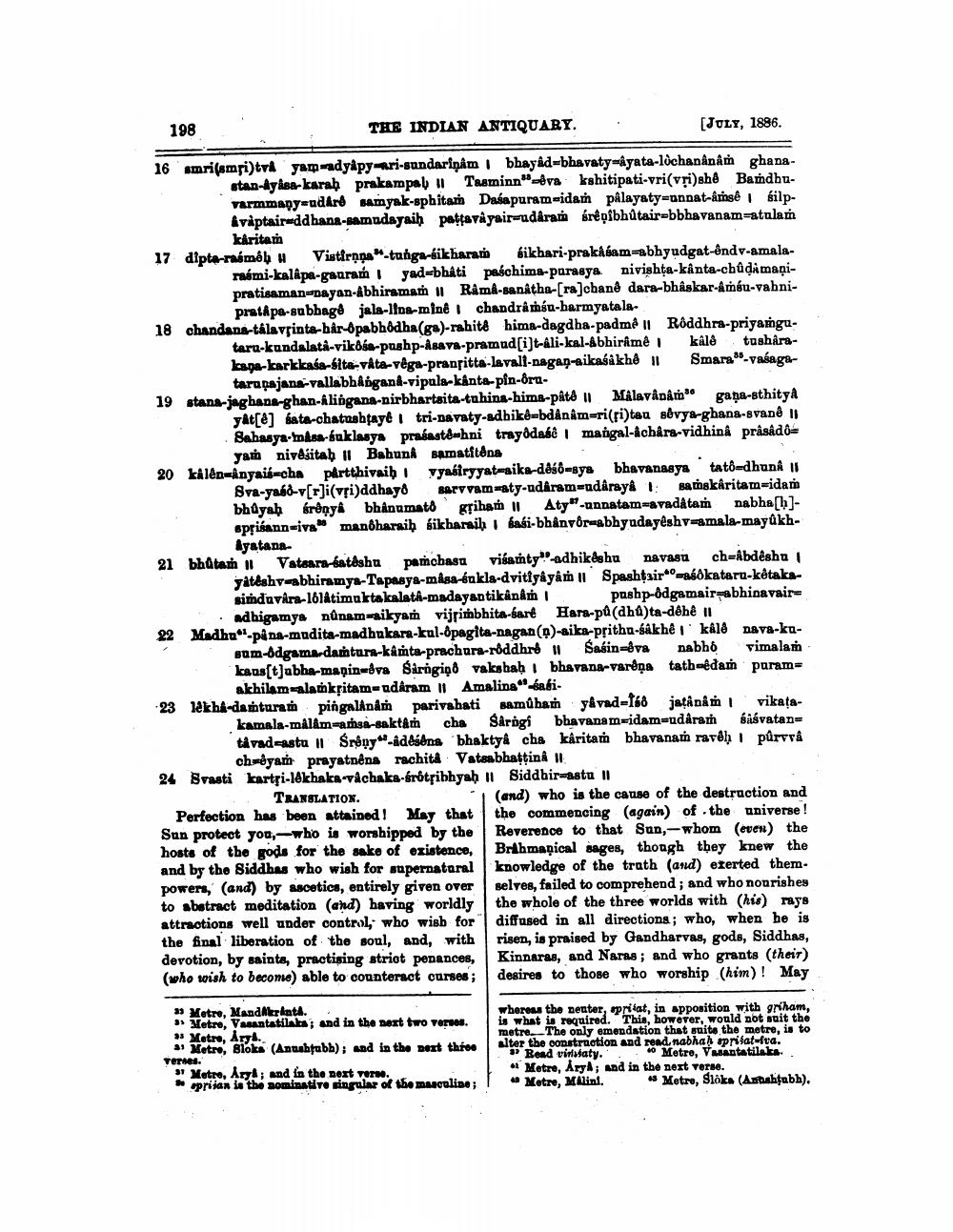________________
198
THE INDIAN ANTIQUARY.
[JULY, 1886.
16 amri(smri)två yam-adyapy-ari-sundariņâm bhayâd-bhavaty-ayata-lòchanânâm ghanastan-ayasa-karah prakampal Tasminn"-va kshitipati-vri(vri)shê Bandhuvarmmany-ndáre samyak-sphitam Dasapuram-idaṁ pâlayaty-unnat-âmsê silpAvaptair-ddhana-samudayaiḥ paṭṭavayair-udaram árêpîbhûtair-bbhavanam-atulam
karitam
17 dipta-raśměl Vistropa-tunga-dikharaṁ sikhari-prakasam-abhyudgat-ênd v-amalarasmi-kalapa-gauram yad-bhati paśchima-parasya nivishta-kanta-chûḍamanipratisaman-nayan-Abhiramaṁ Rama-sanatha-[ra]chanê dara-bhâskar-âméu-vahnipratapa-subhage jala-lina-minê chandrámán-harmyatala18 chandana-talavrinta-har-Opabhodha (ga)-rahitê hima-dagdha-padme | Rôddhra-priyamgukâlê tusharataru-kundalata-vikosa-pushp-asava-pramud[i]t-ali-kal-Abhiramê Smara-vasagakaga-karkkasa-sita-vita-vega-pranritta-lavall-nagan-aikasa khê || tarapajana-vallabbkigand-vipula-kita-pin-bra
19 stana-jaghana-ghan-Alingana-nirbhartaita-tuhina-hima-pâté | Malavânâm gana-sthitya yat[] sata-chatashtayê tri-navaty-adhikê-bdânâm-ri(ri)tau sêvya-ghana-svanê II Sahasya-masa-suklasya prasaste-hni trayodaśê mangal-âchâra-vidhinâ prâsâdô= yam nivesitab II Bahunk samatitena
bhavannsyn 20 kalên-ânyais-cha pártthivaiḥ vyasiryyat-aika-dêśô-sya bhavanasya tatô-dhunâ I Sva-ya-v[](vi)ddhay sarvvam-aty-udaram-udârayê 1 samskaritam=idam nabha[b]bhayaḥ śronya bhanumato griham | Aty"-unnatam-avadatam sprisann-iva manôharaih sikharaih éasi-bhânvôr-abhyudayêshv-amala-mayûkh
Ayatana.
21 bhutam | Vatsara-satéshu pamchasu visaṁty"-adhikeshu
navasu ch=âbdêshu | yateshv-abhiramya-Tapasya-masa-énkla-dvitiyâyâm II Spashtзirasôkataru-kotakasimduvara-lôlâtimuktakalata-madayantikânâm pushp-ôdgamair abhinavair=
adhigamya nûnam-aikyam vijrimbhita-saré Hara-pû (dhú)ta-dêhê 11 22 Madhu-pina-mudita-madhukara-kul-opagita-nagan (n)-aika-prithu-sakhê kalê nava-kuSasin-êva nabho vimalam sum-bdgama-damtura-kâmta-prachura-rôddhré 11 kaus[t]abha-manin-dva Sarigino vakshaḥ bhavana-varêņa tath-êdam puram= akhilam-alamkritam-udaram | Amalina" éagi
kamala-målâm-amsa-saktâm
23 lekha-damturam pingalanam parivahati samûham yavad-168 jațânâm cha Sarigi bhavanam-idam=udaram tavad-astu Śrêny-âdéséna bhaktyâ cha kâritam bhavanam raveh ch-byam prayatnêna rachità Vatsabhaṭṭina II 24 Svasti kartri-lékhaka-vachaka-érôtribhyah
Siddhir-astu ||
(and) who is the cause of the destruction and the commencing (again) of the universe! Reverence to that Sun,-whom (even) the Brahmanical sages, though they knew the knowledge of the truth (and) exerted them. selves, failed to comprehend; and who nourishes the whole of the three worlds with (his) rays diffused in all directions; who, when he is risen, is praised by Gandharvas, gods, Siddhas, Kinnaras, and Naras; and who grants (their) desires to those who worship (him)! May
TRANSLATION.
Perfection has been attained! May that Sun protect you,-who is worshipped by the hosts of the gods for the sake of existence, and by the Siddhas who wish for supernatural powers, (and) by ascetics, entirely given over to abstract meditation (and) having worldly attractions well under control, who wish for the final liberation of the soul, and, with devotion, by saints, practising strict penances, (who wish to become) able to counteract curses;
33 Metre, Mandkrant.
3 Metre, Vasantatilaka; and in the next two verses. as Metre, Ary.
a Metre, Bloks (Anushtabb); and in the next three
verses.
31 Metre, Ary; and in the next verse.
apriian is the nominative singular of the masculine;
vikața
śāśvatan=
pûrvvâ
whereas the neater, spriat, in apposition with griham, is what is required. This, however, would not suit the metre. The only emendation that suits the metre, is to alter the construction and read nabhaḥ spritat-tva. Read vinssaty. 40 Metre, Vasantatilaka. Metre, AryA; and in the next verse. 43 Metre, Malini.
45 Metre, Sloka (Anushtabh).




